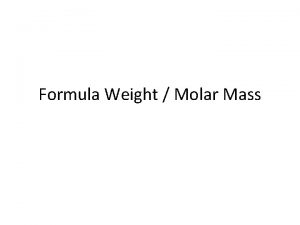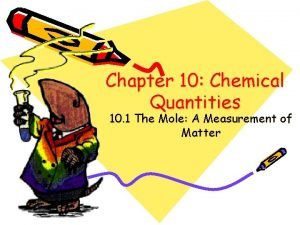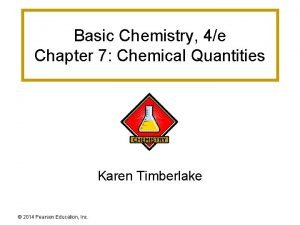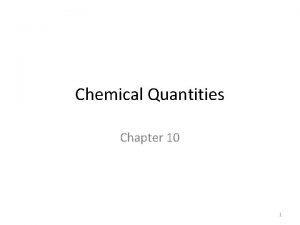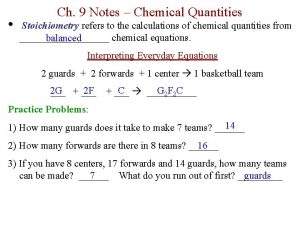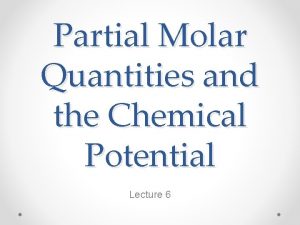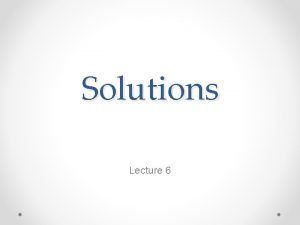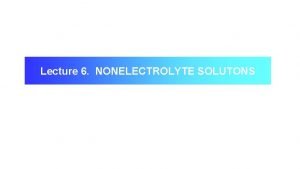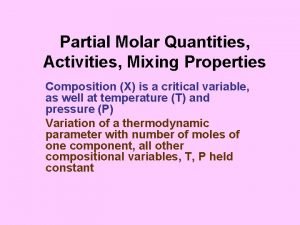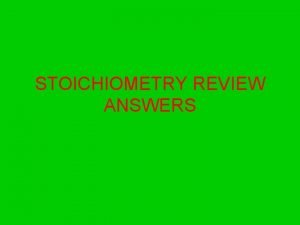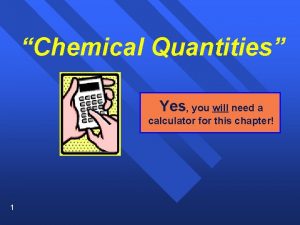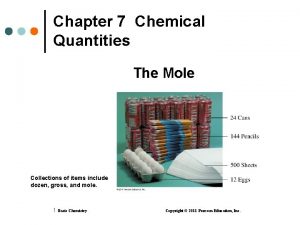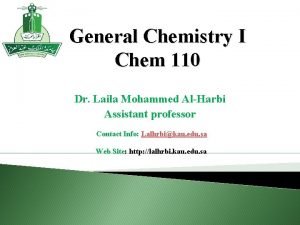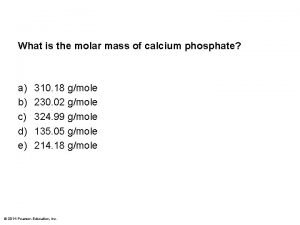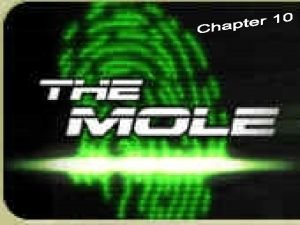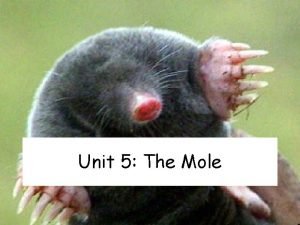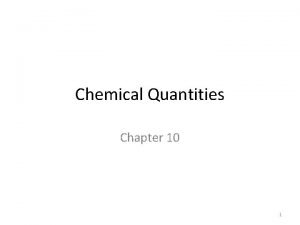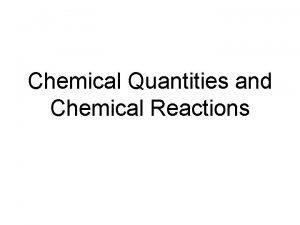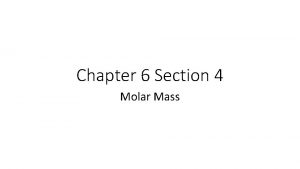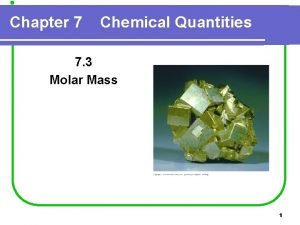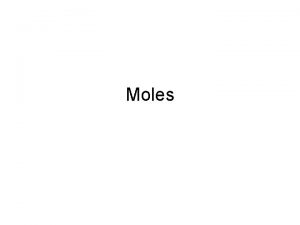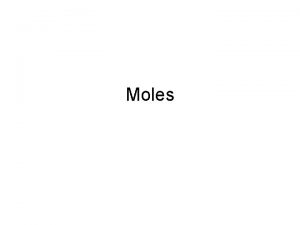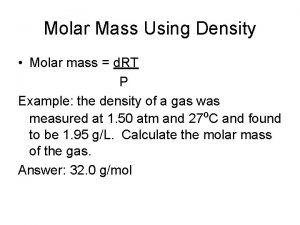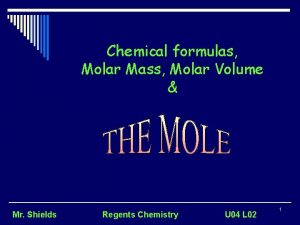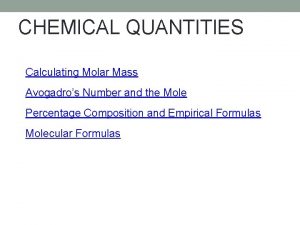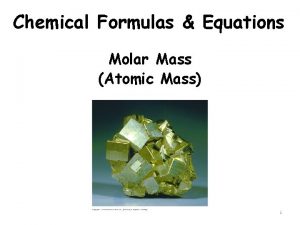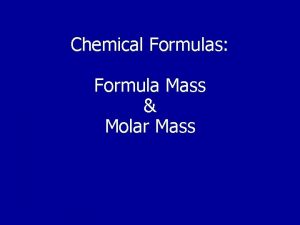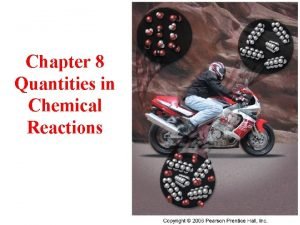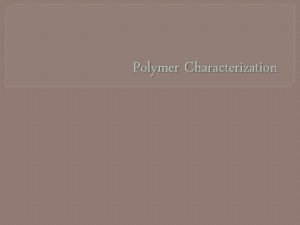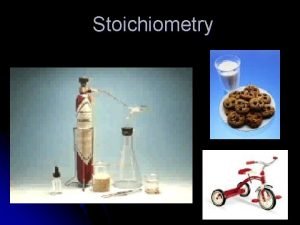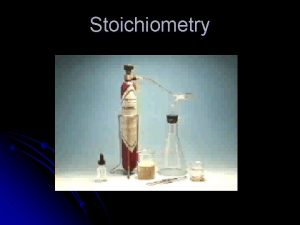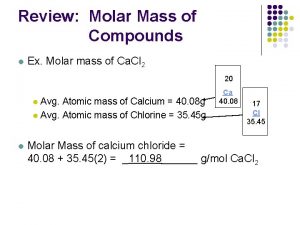Chemical Quantities Chapter 10 1 Molar Mass Molar




























- Slides: 28

Chemical Quantities Chapter 10 1

Molar Mass • Molar mass is the sum of atomic masses of the elements in the compound. – You MUST take into account the number of atoms of each element. Example: Ca 3(PO 4)2 Ca 3(40. 08) P 2(30. 97) +O 8(16. 00) 310. 18 g Ca 3(PO 4)2 Significant figure rules: – when adding or subtracting keep the smallest number of decimal places. – The number of atoms is a counted quantity and has infinite significant figures. 2

Equality Statements • Chemistry requires converting between different units of measure. • Mole (mol) is the amount of a substance and can be used to show relationships between other units. • 1 mol = 22. 4 L {of any gas at STP} • 1 mol = 6. 02 x 1023 particles (ptl) • 1 mol = molar mass g 3

Equality Statements • Note STP means standard temperature and pressure. – Which is 1 ATM and 273 K • Molar mass is measured in grams and students must find it for each chemical formula. • Particles can include: – Atoms (unique to elements) – Molecules (unique to covalent compounds) (mlc) – Ions (unique for ions) – Formula Units (unique for ionic compounds) (F. U. ) 4

One Step conversions • Chemistry conversions are all about canceling out the undesired unit to get the desired unit. • When doing conversion you MUST show – Numbers – Units {mol, mlc, F. U, g, L} – Chemical Formulas {example: Ca 3(PO 4)2} • Steps 1. Write number and unit given in the problem 2. Multiply by a fraction so that units cancel What every your getting rid of goes on bottom, what every our going to goes on top. 3. Add the correct numbers form your equality statments. 5

One Step Conversions • 6

Two Step Conversion • Only allowed to convert using the equality statements below – 1 mol = 22. 4 L {of any gas at STP} – 1 mol = 6. 02 x 1023 particles (ptl) – 1 mol = molar mass g • When going from grams to L or particles to grams (ect) it requires two conversion factions. • The order of the units in the fractions are determined by what you are starting with and what you want to go to. 7

Two Step Conversion Raines Mole Map Each bridge is a fraction! • • Mole is always 1 Volume is always 22. 4 L Particles is always 6. 02 x 1023 ptl Mass is always molar mass of compound/element in grams. 8

Two Step Conversion 9

Two Step Conversion 10

Two Step Conversion • Example 1 11

Text book mole map 12

Percent composition • 13

Percent Composition Example 1 Find the percent composition of each element in H 2 O • Mass of H 2 O = 2(1. 01)+1(16. 00)=18. 02 g • Mass of hydrogen in H 2 O = 2(1. 01) =2. 02 g – % comp of hydrogen = 2. 02 g/18. 02 g x 100= 11. 21% hydrogen • Mass of oxygen in H 2 O = 1(16. 00)=16. 00 g – % comp of oxygen = 16. 00 g/18. 02 g x 100= 88. 79% oxygen • Check: 11. 21% hydrogen + 88. 79% oxygen = 100 % total so work was correct 14

Percent Composition Example 2 Find the percent composition of each element in Ca 3(PO 4)2 • Mass of Ca 3(PO 4)2= 3(40. 08) + 2(30. 97) + 8(16. 00)= 310. 18 g • Mass of Calcium in Ca 3(PO 4)2 = 3(40. 08) = 120. 24 g – % comp of calcium = 120. 24 g/310. 18 g x 100 = 38. 76 % Ca • Mass of phosphorous in Ca 3(PO 4)2 = 2(30. 97) = 61. 94 g – % comp of phosphorous = 61. 94 / 310. 18 x 100 = 19. 97% P • Mass of oxygen = 8 (16. 00) = 128. 00 g – % comp of oxygen = 128. 00 g /310. 18 g x 100 = 41. 27% O • Check: 38. 76 % + 19. 97% + 41. 27% = 100% 15

Percent composition • 16

Percent composition with masses • 17

Using Percent Composition • If you know the percent composition (or can calculate it) it can be used to find the mass of an element in compound. • total Mass (% in decimal form) = mass of element • Example: You have a 58. 24 g sample of a substance that contains 25. 0% hydrogen. What is the mass of hydrogen in the sample – 58. 24 g (. 0250)=14. 56 g hydrogen 18

Using Percent Composition • 19

Empirical formula • Empirical formula gives the lowest wholenumber ratio of the atoms of the elements in a compound • An empirical formula may or may not be the same at a molecular formula • The empirical formula of a compound shows the smallest whole-number ratio of the atoms in the compound • Example: methane is C 2 H 6, empirical formula would be CH 3. 20

Finding Empirical Formulas 1. IF given % assume you have a 100 g sample and the % turns into grams. 2. Turn grams of each element into moles of the element. (use mass to mole conversion). 3. Get whole number ratio of elements. (Divide all by smallest # of moles) 4. Use whole numbers as subscripts in chemical formulas 21

Empirical formula example 1 • Find empirical formula for compound containing 67. 7% mercury, 10. 8% sulfur, and 21. 6% oxygen. 1. 67. 7 g Hg, 10. 8 g S, 21. 6 g O 2. Mole Hg= 67. 7 gx (1 mol/200. 59 g) =0. 34 mol. Hg Mol S = 10. 8 g x (1 mol/32. 07 g)=0. 34 mol S mol O = 21. 6 g x (1 mol/16. 00 g)= 1. 35 mol O 3. # of Hg = (0. 34/0. 34) = 1 Hg # of S = (0. 34/0. 34) = 1 S # of 0 = (1. 35/0. 34) = 3. 97 = 4 O 4. Hg. SO 4 22

Empirical Formula • When you find the ratio of atoms be on the look out for numbers that indicate you have to multiply. – Ratios of 1. 5, 2. 5 …. Indicate you need to multiply by 2 – Ratios of 1. 33, 2. 33 … indicate you need to multiply by 3 • If your ratio is very close to the whole number round to the whole number. 1. 02 would round to 1, 2. 97 would round to 3. 23

Empirical formula example 2 • 24

Molecular formula • 25

Molecular Formula Example 1 • 26

• Example 2 27

• Example 2 28
 Angular acceleration formula
Angular acceleration formula Grams to moles
Grams to moles Unit of molar mass
Unit of molar mass Molar mass unit
Molar mass unit Mol to particles
Mol to particles How to find mol from mass
How to find mol from mass Mass number formula
Mass number formula Atomic mass vs molar mass
Atomic mass vs molar mass Chapter 7 chemical quantities answer key
Chapter 7 chemical quantities answer key Chemistry chapter 10 chemical quantities
Chemistry chapter 10 chemical quantities Chapter 7 chemical quantities answer key
Chapter 7 chemical quantities answer key Chemical quantities chapter 10
Chemical quantities chapter 10 Chapter 10 chemical quantities practice problems answer key
Chapter 10 chemical quantities practice problems answer key Chapter 9 chemical quantities
Chapter 9 chemical quantities Partial molar quantities
Partial molar quantities Partial molar quantities
Partial molar quantities Partial molar quantities
Partial molar quantities Partial molar quantities
Partial molar quantities The calculation of quantities in chemical equations
The calculation of quantities in chemical equations The calculation of quantities in chemical equations
The calculation of quantities in chemical equations Chemical quantities calculator
Chemical quantities calculator Unit chemical quantities the mole 1 step
Unit chemical quantities the mole 1 step Which of these quantities represents the largest mass?
Which of these quantities represents the largest mass? Empirical formula pogil
Empirical formula pogil 7-3 practice problems chemistry answers
7-3 practice problems chemistry answers Chapter 18 chemical reactions balancing chemical equations
Chapter 18 chemical reactions balancing chemical equations Molar mass of calcium phosphate
Molar mass of calcium phosphate Molska masa
Molska masa How to calculate molar mass
How to calculate molar mass






